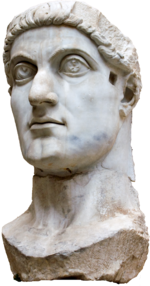
Back حملات قسطنطين الجرمانية والسارماتية Arabic Campañas germanas y sármatas de Constantino Spanish لشکرکشیهای ژرمنی و سارماتی کنستانتین بزرگ Persian Campagnes de Constantin Ier contre les Germains et les Sarmates French Campagne germanico-sarmatiche di Costantino Italian
| German and Sarmatian campaigns of Constantine | |||||||||
|---|---|---|---|---|---|---|---|---|---|
| Part of Germanic Wars | |||||||||
 Emperor Constantine I | |||||||||
| |||||||||
| Belligerents | |||||||||
|
| Germanic and Sarmatian peoples | ||||||||
| Commanders and leaders | |||||||||
|
| Rausimodus | ||||||||
| Units involved | |||||||||
| Numerous legions | Many people, amounting to some hundreds of thousands of armed | ||||||||
The German and Sarmatian campaigns of Constantine were fought by the Roman Emperor Constantine I against the neighbouring Germanic peoples, including the Franks, Alemanni and Goths, as well as the Sarmatian Iazyges, along the whole Roman northern defensive system to protect the empire's borders, between 306 and 336.
After becoming controller of the western provinces along the Rhine limes (in 306) following the death of his father Constantius Chlorus (Augustus of the west) in 306, Constantine initially concentrated his forces on defending this area of the frontier against the Franks and Alemanni, making Augusta Treverorum his first capital for this purpose. Having defeated the usurper Maxentius at the Battle of the Milvian Bridge in 312,[2] all Italia passed under Constantine's control and he thus became the sole Augustus of the West.
In February 313, Constantine (who had spent the winter in Rome) formed an alliance with the Emperor of the East, Licinius, reinforced by Licinius' marriage to Constantine's sister, Flavia Julia Constantia.[3] However, this alliance survived for only a few years, before the two Augusti came into conflict in 316. Constantine defeated Licinius, who was forced to cede Illyricum to Constantine,[4] but not Thrace.[4] Constantine advanced ever further east with his territorial acquisitions, now having to defend the important strategic region of the limes sarmaticus (from 317).
In the following years, Constantine mostly occupied himself in the central section of the Danubian Limes, mostly fighting against the Sarmatians in Pannonia,[5] residing at Sirmium almost continuously until 324 (when he moved against Licinius once more), making it his capital[6] along with Serdica.[7] At this time Constantine also demonstrated a very active military bent, travelling along the whole of the limites of his newly acquired territory. From 320 he appointed his eldest son, Crispus, Praetorian prefect, with military command of Gaul.
When he learnt that an army of Goths[8] had crossed the Danube to raid Roman territory in Moesia Inferior and Thrace, which belonged to Emperor Licinius,[9] he left his general headquarters in Thessalonica[10] and marched against them (323). The fact that he had trespassed into a part of the empire which was not under his control unleashed the final phase of the Civil wars of the Tetrarchy, which ended with the complete defeat of Licinius and the consecration of Constantine as the sole Roman Emperor.[11]
The final period of Constantine's reign, until his death (337), saw the Christian Emperor consolidate the entire defensive system on the Rhine and Danube, obtaining important military successes and reasserting control over a large part of the territory that the Romans had abandoned under Gallienus and Aurelian: the Agri Decumates from the Alemanni, the area south of the Tisza from the Sarmatians, as well as Oltenia and Wallachia from the Goths.
- ^ Cite error: The named reference
JulDeCaes329cwas invoked but never defined (see the help page). - ^ Eutropius, Breviarium ab Urbe condita, 10.4.
- ^ Zosimus, New History, 2.17.2.
- ^ a b Cite error: The named reference
ZosimoII,20,1was invoked but never defined (see the help page). - ^ Cite error: The named reference
CIL8,8412was invoked but never defined (see the help page). - ^ Cite error: The named reference
Mócsy277was invoked but never defined (see the help page). - ^ Cite error: The named reference
Horst214-276was invoked but never defined (see the help page). - ^ Cite error: The named reference
AurVictDeCaes41was invoked but never defined (see the help page). - ^ Cite error: The named reference
Valesiani5.21was invoked but never defined (see the help page). - ^ Cite error: The named reference
ZosimoII,22,3was invoked but never defined (see the help page). - ^ Cite error: The named reference
ZosimoII,28,2was invoked but never defined (see the help page).
© MMXXIII Rich X Search. We shall prevail. All rights reserved. Rich X Search